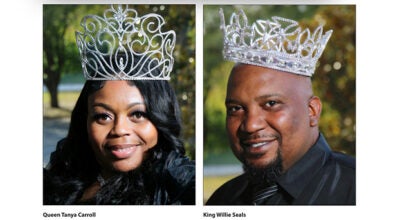Parade starts in Vidalia headed for National Cemetery
Published 12:02 am Wednesday, May 22, 2013

File Photos/The Natchez Democrat — With American flags at the ready, a dance team lines up at the beginning of the annual Memorial Day Parade, which starts in Vidalia and marches across the Mississippi River on the eastbound bridge.
The beat of a bass drum means more to Marvin Warner Jr. than just musical melodies being played in perfect harmony on the Mississippi River bridge.
It’s a way to pay respect to fallen veterans and carry on a tradition that dates back as far back as 1867, when Miss-Lou residents celebrated Memorial Day by crossing the Mississippi River by ferry, walking to the top of Silver Street and marching to the cemetery. After the bridge was built in the 1940s, residents began marching across the bridge to the cemetery.
Seeing the older children in his neighborhood march proudly every year with their instruments motivated Warner to pick up the sticks and join when he was just 10 years old.
“I always looked up to the older guys who were marching and just wanted to be right there with them one day,” Warner said. “I started at the bottom as a little scrappy kid just asking if I could play along with the guys.
“I progressed and progressed and before I knew it I was in the band, and now I’ve been doing it for 15 years.”
The tradition, Warner said, is one his family has been participating in for as long as he can remember.
“This is more than a parade — it’s a way to honor those who have served our country,” he said. “We’re marching for all the soldiers — enlisted, serving or fallen — and their families.”
The march, Warner said, became even more significant to him when he enlisted in the Army. He served as a gunner and driver with the National Guard’s 1086th transportation company and was deployed to Afghanistan last year.
Warner returned in February because of a shoulder injury that caused him to have reconstructive surgery.
The time Warner spent overseas taught him the importance of carrying on traditions such as the Memorial Day parade, he said.
“Just like it’s happened in the past, at some point the responsibilities are going to rotate through, so we try to help all the younger kids out to get them ready,” Warner said. “It means a lot to have them looking up to us and showing them what we do and why we do it.”
Jordan Thomas, 14, is among the younger drummers quickly moving up the ranks in the marching band.
Thomas said he started playing with the band three years ago after having watched the parade growing up.
“I had seen them march and practice and just asked if I could play with them,” Thomas said. “I’m excited to march and play with them again this year.”
Parade coordinator Eddie Coleman said he enjoys seeing the younger generations begin to participate in the activities.
“When we can get people involved who weren’t part of the tradition before, it just helps it grow and continue,” Coleman said. “We wouldn’t stop this parade for the world.”
Coleman said the tradition of the march dates back to 1864 when a group of soldiers marched to the Natchez landing and crossed the river on a steamboat to land in Vidalia.
Soldiers of African descent had only recently been allowed to serve in the Union Army as a result of an Act of Congress passed on May 22, 1863, which created the formation of regiments of U.S. Colored Troops, according to information provided by Coleman.
As a result, local black men, all recently emancipated slaves, enlisted in the Union army at Natchez.
Union Lt. Col. Hubert A. McCaleb, commander of the 2nd Mississippi Heavy Artillery, called seven companies to arms and crossed the river on a steamer.
McCaleb’s men opened fire on an estimated 1,500 Confederate soldiers near Trinity Road, which led to present day Jonesville. The skirmish killed one and wounded five before the Confederate troops retreated.
McCaleb said his “force of 300 colored soldiers” carried the day. It was the first time local black men, dressed in a Union uniform, were given the opportunity to fight for their own freedom, according to the information provided by Coleman.
Shortly after, veterans gathered in Illinois and formed an organization called the Grand Army of the Republic (GAR).
On May 5, 1868, Gen. John A. Logan declared that local GAR chapters would honor their fallen comrades with their own celebration.
Two local GAR chapters formed — one in Natchez and one in Vidalia — and the annual Memorial Day parade was arranged to observe the members of the GAR who are buried at the Natchez National Cemetery.
This year’s procession will line up at 8 a.m. Monday and leave from the Grand Army of the Republic Post No. 23 at 604 N. Magnolia St. in Vidalia walking to the Natchez National Cemetery.
Participants will march across the bridge and take a break near the Natchez Visitor Reception Center before continuing to the cemetery, Coleman said.
Frank Williams, who is commander of the American Legion Sidney Shorter Post 590 in Vidalia, said he’s been leading the march since 1946 and doesn’t intend to stop anytime soon.
“As long as there’s a breath in my body, I’ll keep going,” Williams said, laughing. “Right now, I’m holding onto the honor of leading until I have to give it up, but someday I want to pass it on it.
“We need to keep this tradition alive.”






